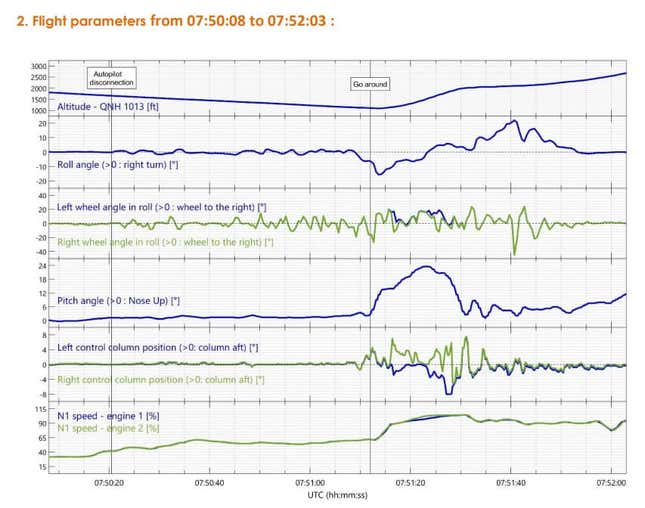
Earlier this month, pilots of an Air France Boeing 777 reported that their aircraft had lost control after it failed to respond to control inputs during landing. Investigators looking over the data have found that both pilots were pulling on the controls in opposite directions, causing their own observations.
On April 5, Air France flight AF011 was on its final approach to Charles de Gaulle Airport in Paris from New York’s John F. Kennedy International Airport. During the approach, the Boeing 777-300ER (registration F-GSQJ) veered left. Inside of the flight deck, the pilots could be heard on air traffic control audio shouting “Stop! Stop!” and struggling while warning chimes blared in the background.
Thankfully, the pilots were able to perform a go-around, then line up for a second attempt at landing. The second try went off without a hitch.
The question of what happened that day has been up in the air, and France’s Bureau d’Enquêtes et d’Analyses pour la Sécurité de l’Aviation (BEA) seeks to find an answer. Investigators have released a preliminary report, and the evidence thus far suggests that there wasn’t anything wrong with the plane, but confusion in the cockpit. For context, “PF” in BEA’s statement below means “Pilot Flying.”
On final, the aeroplane was established on the localizer and glideslope ILS beams. At 07:49, the crew were cleared to land. They configured the aeroplane for landing, the selected speed was 140 kt. The crew then carried out the “Landing” checklist. At 07:50:20, when the aeroplane was at an altitude of 1,670 ft5 , the PF continued the approach in manual flight: he disconnected the autopilot (AP), leaving the auto throttle (AT) and the flight directors (FD) activated. He then made inputs on the controls for around 15 seconds. The aeroplane followed the movement of the controls and stayed on the ILS path, the left and right roll being less than 2°. In the subsequent ten seconds, there were less inputs on the wheel. The co-pilot than made inputs on the control column and wheel with a greater frequency, the amplitude was still small, the aeroplane followed the commands, the left and right roll being less than 3°. At 07:51:06, the co-pilot expressed his astonishment with respect to the aeroplane’s bank angle. The roll inputs were amplified and the average position of the wheel was at around 6° to the left. The aeroplane turned left with a small bank angle.
In short, the autopilot was disconnected, and the aircraft was following the inputs entered. The pilot flying was apparently surprised with the aircraft deviating from its path.
When the aircraft was at an altitude of 1,115 feet, the pilots decided to perform the go-around. At that time, the aircraft was banked seven degrees to the left with the control wheel pointed 16 degrees to the left. BEA notes that the aircraft was still in a stabilized approach and could have landed safely.
The confusion would only be amplified during the go-around. According to the preliminary report, both pilots began pulling on their control columns in opposite directions. The Captain was making nose-down inputs while the First Officer was making nose-up inputs. The control wheels were also calling for even more bank.
At this time, the BEA investigation has found nothing wrong with the aircraft itself.

Normally, one pilot is in control of the aircraft (Pilot Flying) while the other handles communications and monitors what the plane is doing (Pilot Monitoring). When pilots exchange duties, it’s practice for the pilot taking control to call out, “I have control.” In this case, the data suggests that both pilots were trying to fly the plane, and because they both were inputting opposite inputs, they were creating the assumed loss of control that they reported.
As for the warning chimes going off? BEA explains that the push-to-talk and autopilot switches were being hit a number of times, causing audible warnings to sound over and over.
The Boeing 777 is fly-by-wire, but its control columns are mechanically linked, which can allow for a situation like this to occur. This link is maintained with a torque tube breakout mechanism. When enough opposing force is applied, the link breaks. It’s designed so that the plane can remain under control if one of the columns gets jammed.
The BEA will continue its investigation. It will continue to validate the data and attempt to replicate what happened in the cockpit that day to gain a better understanding of the forces that were applied to the controls to the movements of the controls.